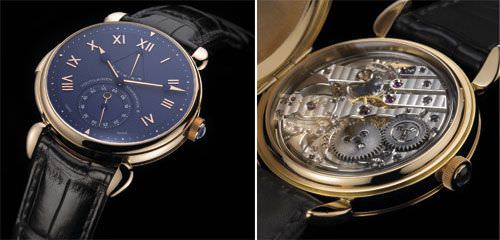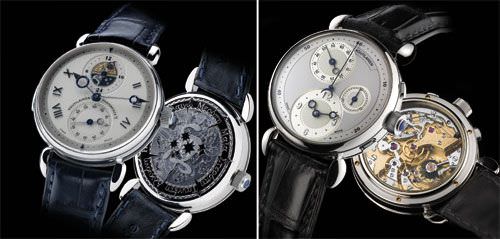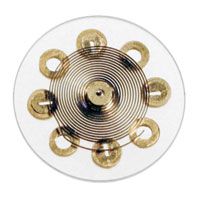
“Since my youth, I knew that I wanted two things,” explains Kari Voutilainen. “I wanted to do something with my hands, and I wanted to be independent.” It took him 16 years to learn “to do something” with his hands and he became “independent” four years ago.
At the age of 22, Voutilainen entered the watchmaking school in Tapiola, located in the suburbs of Helsinki. It was here that he finally discovered his true vocation and “for the first time” in his life, as he reminisces, he “was happy to attend school”. After graduation, the young watchmaker spent a year working in after-sales service, where he discovered many types of pocket watches and learned the art of restoration. But, he was hungry for more knowledge, and in 1988, Voutilainen enrolled at Wostep, the centre for perfecting the art of watchmaking, situated in Switzerland, where he took courses in complicated watches.
Returning to his native Finland, Voutilainen set up an independent workshop. Business was good and he did “a fair amount of repair work”. Above all, however, he “learned how to organize himself”.
The “doors of dreams”
In 1990, he was presented with a new opportunity, one that would decide his destiny. He was hired by Michel Parmigiani, who at that time was essentially working in watch restoration. Here, the “doors of dreams” opened for the young Voutilainen. “Imagine,” he tells us, with emotion in his voice, “that I was able to restore 11 exceptional tourbillons, pieces that were designed and created to participate in the Observatory Competitions of the epoch. They were absolute marvels for a young watchmaker.”
During nearly ten years, Kari Voutilainen would continue to perfect his knowledge and savoir-faire while with Michel Parmigiani, whose activities began to progressively change. “Michel began to make perpetual calendars, minute repeaters, additional mechanisms, special pieces…”
While at Parmigiani, Voutilainen met a man who would change his life: Charles Meylan, who had become, after his retirement, the premier watchmaker in the ateliers of Michel Parmigiani. Meylan, who had attended the watch school in the Vallée de Joux in the 1930s and whose savoir-faire was “enormous,” became Voutilainen’s veritable Master. “He opened all the doors for me, and confided all his secrets. He transmitted to me a colossal amount of knowledge,” says Kari Voutilainen, “so much so that, little by little, I began to feel totally at ease with the most complicated watches. I could easily fabricate their parts, their gears, their springs, while working only in the most traditional methods.”
Then in 1999, Wostep asked him to move to the other side of the fence, and become an instructor in mechanical watches. He accepted and taught until 2002, when he decided to finally set up his own independent workshop.

Voutilainen Masterpiece 6

Voutilainen Masterpiece 7
Voutilainen Masterpiece Chronograph
Independence
Voutilainen and his family moved to Môtiers, in the Val de Travers, a region where the renaissance of mechanical watchmaking was in full bloom. (For example, this area is home to Parmigiani, the Vaucher manufacture, Chopard’s L.U.C. manufacture, Bovet’s ateliers, the Piaget manufacture, the recent Val Fleurier manufacture, etc.) He rapidly received major orders for movements and prototypes, but his mind was elsewhere. He was nurturing a dream to finally create his own movements.
In 2003, he decided to take the plunge and, two years later, in 2005, Voutilainen was present, for the first time, at BaselWorld, at the stand of the Horological Academy of Independent Creators. He immediately became a sensation with a minute repeater that had a unique particularity: it chimed the hours and the minutes, but in place of the traditional quarter-hour, it chimed every ten minutes! “It is much simpler for the ear,” explains Kari Voutilainen, “for those of us who are used to the decimal system.”
He designed his first minute repeater, with a power reserve indicator, based entirely on an ancient ébauche, totally reworking the movement and giving it a high quality and unusual manual finish. However, the most significant impressions were made at the show by the volume and the exceptionally crystalline nature of the chime’s sound. Voutilainen explains his creation: for the case, he collaborated with a friend and fellow artisan, Gideon Levingston, a goldsmith working in the traditional methods, totally by hand, “which is not done, at all, anymore in Switzerland,” adds the watchmaker. Rather than starting with a kilo ingot of gold and working with the softest material possible, as is the case for industrial case makers, “Gideon commences with a thin sheet of gold, which he works by hand to create the shape of the case, using the material’s own tension. This tension is fundamental. It is what will transform the case into a veritable resonance casing, while the industrial method cuts the nerves of the material.”
His second watch is also a decimal minute repeater, but equipped with a second time zone whose hour adjustment is made by a simple push of the crown. Crafted in white gold and endowed with a timeless design, it is superbly engraved on the back with a motif evocative of the seven muses.
A chronograph between the 18th and 21st centuries
While a third minute repeater with complications is currently in the pipeline, Kari Voutilainen has started production of a series of manual chronographs entirely designed in his atelier. Made in-house of white gold, with a gold dial and gold and steel hands, it is, “above all, an elegant and classic timepiece that also has timing functions,” says Voutilainen.
With an ultra classic appeal of a regulator (the hours and minutes are placed at 6 o’clock, the seconds at 11 o’clock, and the minute counter at 3 o’clock, all with subtle guilloché sub-dials), it offers exceptional readability. The finishing is also outstanding: hand polishing and chamfering of the bridges, springs, levers, column wheel… But what is especially striking in this watch, created solely using 18th century techniques, is the presence of a revolutionary balance spring called CarbontimeTM.
CarbontimeTM
Developed by the same Gideon Levingston who manually fashions his watch cases, the CarbontimeTM balance spring required six years of development, using a combination of mathematical analyses and the technology of ultra modern materials. The primary goal was to be totally anti-magnetic, and completely resistant to thermal variations, thus offering extraordinarily precise operation.

CarbontimeTM
Without going into the very technical details of this watchmaking grand premiere, Gideon Levingston achieved this result by including a spring made of composite carbon fibre in an ultra-fine balance in the shape of a quartz disk. In order to obtain the required amplitude and frequency, this transparent disk, whose density is very low, is made heavier by the addition of small rings of tantalum and gold, attached to curved strips, which, in the case of thermal compensation, retract, thus reducing the inertia when necessary.
Integrating the most advanced technology into watches, which are conceived, created and produced in the most traditional manner possible. This is exemplary of the contribution to the art of timekeeping made by the master watchmaker Kari Voutilainen, an independent creator who is not content to simply reproduce the feats of the past, but who is actively clearing new ground for the future.
Source: Europa Star August-September 2006 Magazine Issue




